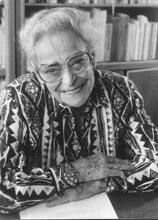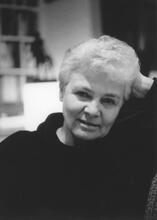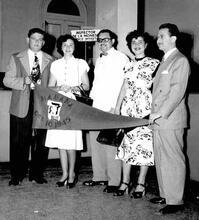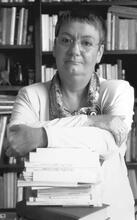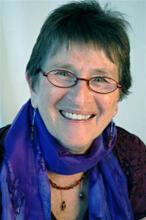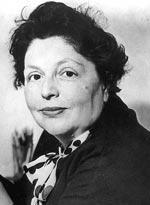Rivkah Perelis
Rivkah Perelis was born in 1913 in Milejczyce, Poland, the youngest of six. As a teenager she joined the Zionist youth movement He-Haluz ha-Za’ir and remained a committed member until she emigrated to Palestine in 1938, one year before the German annexation of Poland. Her mother and two of her sisters, who remained in Milejczyce, were murdered in Treblinka in 1942. In 1961, Rivkah returned to school, receiving her bachelor’s degree in literature and Jewish history from Hebrew University in Jerusalem in 1964 and her master’s in 1968. She then pursued her doctorate with a dissertation on the Polish Zionist youth movement during occupation. Perelis received her doctorate in 1982 and died the following year. Her research was published posthumously in a book in 1987.
Early Life and Family
Rivkah Perelis was born in 1913 in the village of Milejczyce near Bialystok. Her father, Rabbi Aaron Samuel Tamares (1869–1931), a writer and thinker who also went by the pen name “Ahad Ha-Rabbonim ha-Margishim,” was one of the most original figures of his time and place. He published numerous books and articles in Hebrew and Yiddish, in which he spoke out harshly against the wealthy, the gabba’im (synagogue officers) and community leaders, who ignored the suffering and hardship of the weak.
Her mother, Rachel, was the youngest daughter of the rabbi of Milejczyce. She married Aaron Samuel in 1886 after her older sister, who was due to marry him, died and her father asked Aaron not to leave the village but to marry Rachel and eventually succeed him as the town’s rabbi. Aaron married Rachel, was appointed the town’s rabbi in 1893, and died of cancer in 1931.
Perelis was the youngest in a family of six sons and daughters. Her mother, her oldest sister Miriam with her husband Rabbi Ya’akov Lifshitz and their son Shmuel, her sister Zirka and husband Yehoshuah all remained in Milejczyce and were murdered in Treblinka on November 20, 1942. Her brother Shelomo emigrated to Palestine in 1933; her sister Hannah and brother David also emigrated to Palestine.
Rivka received her elementary education at the local Polish school and studied Hebrew with her older sister Miriam. Her father taught her Bible, Codification of basic Jewish Oral Law; edited and arranged by R. Judah ha-Nasi c. 200 C.E.Mishnah, and Lit. "teaching," "study," or "learning." A compilation of the commentary and discussions of the amora'im on the Mishnah. When not specified, "Talmud" refers to the Babylonian Talmud.Talmud at a young age. His ethical personality, she wrote, was the dominant influence in her life. Perelis continued her studies at the Tarbut Hebrew teachers’ college in Grodno, graduating with honors.
Joining the Zionist Movement and Making Aliyah
At the age of thirteen she became a member of the Zionist youth movement He-Haluz ha-Za’ir and after a brief period working on the group’s hakhsharah (training) A voluntary collective community, mainly agricultural, in which there is no private wealth and which is responsible for all the needs of its members and their families.kibbutz at Luck, she joined the central chapter in Warsaw. She remained there for four years, serving as a member of the secretariat, organizing movement operations in the various districts and chapters and training youth-group leaders. In 1937 she participated in the Twentieth World Zionist Congress in Zurich as a member of the Labor Palestine list. In 1938 she played an active role in the unification of the Freiheit and He-Haluz ha-Za’ir movements. She married Yitzhak Perelis (1910–1983) that same year and at once immigrated to Palestine while Yitzhak stayed behind at the movement’s headquarters in Warsaw; the next year, Germany invaded and annexed. In April 1940, Yitzhak arrived at Kibbutz Yagur, where the coupled raised their three children—Naomi Shimshi (b. 1942), Mira Lev (b. 1946) and Amos (b. 1953).
During her early years as a member of Yagur, Perelis worked in farming and held various public posts. She was the kibbutz secretary during the War of Independence and served as a counselor both in the Titz Vocational School at Yagur and for the youth group of the Tehran children (a group of Polish refugee children who made their way to Palestine via Tehran early in World War II to escape the Nazi invasion). After continuing her studies at the Seminar ha-Kibbutzim teachers college in Tel Aviv, she taught at the school on Yagur, later becoming principal.
Pursuing Higher Education
From 1961 to 1964 she pursued a bachelor’s degree at the Hebrew University of Jerusalem, majoring in literature and Jewish history and graduating with distinction. During this period she authored her first two studies: “The Beginnings of the Po’alei Zion Party” and “Emergence of a Movement: He-Haluz ha-Za’ir in Poland.” In 1964 she returned to the field of education, serving as teacher and principal at the Carmel-Zevulun Regional School, which she helped found. Concurrently, she continued her studies for a master’s degree in Jewish history at the Hebrew University of Jerusalem.
In 1968, after submitting her master’s thesis, entitled “The Dror Movement: Its Ideological and Practical Evolution From the Onset of World War II to the Major Aktion in Warsaw,” Perelis was accepted as a research fellow in the doctoral program, with Professor Yehudah Bauer as her mentor. Her doctoral dissertation, “Pioneer Youth Movements in Occupied Poland,” is an original study of the local and nationwide activities of the pioneer movements in Poland from September 1939 until the end of 1943. Its focus is the unique historical and psychosocial character of the pioneer movement, which succeeded in creating and perpetuating itself, initially as a clandestine educational movement and later as an underground fighting force.
As a historian, Perelis strove for moral principles, accuracy and the utmost openness, without sacrificing the personal emotional motivation behind her work. She struggled with the inevitable dilemma of every historian when dealing with the Holocaust—the dichotomy between the sense of personal-emotional commitment and the professional obligation to maximum objectivity—and learned to live within this contradictory space.
Research Findings
The central question posed by Perelis in her research is how to explain the fact that a movement that cut itself off ideologically from involvement in community life in the Lit. (Greek) "dispersion." The Jewish community, and its areas of residence, outside Erez Israel.Diaspora, and was essentially limited to a very young age group, took upon itself the responsibility of leading a public in danger of extermination toward a course of resistance, initially without arms and later, with weapons in hand.
The question is answered by analyzing the uniqueness of the pioneer Zionist movement: it is precisely this deliberate severance from the organized community (which had characterized the movement before the war) that enabled these young people to see things that their more experienced elders could not, and to draw the conclusions that later led to their unconventional response.
The reality of oppression, hunger, and death took over so quickly that the traditional leadership was unable to adapt. It was actually the leadership of the pioneer youth movements—made up of young people who had already experienced the revolutionary notion of resistance while building and sustaining a new reality in Palestine and the kibbutz settlement movement—that was capable of grasping the uniqueness of the situation.
The sense of togetherness of the youth movements, the group identification that served as a substitute for the murdered family, was also a source of strength in consolidating the movements in preparation for the transition from educational framework to fighting underground.
Perelis’s research offers a portrait of the individual as part of the movement, of daily life in the movement, of the constant dedication to the task at hand, combining these fragments into a complete picture. Despite her insistence on academic accuracy and her attention to the tiniest detail, one senses that Perelis is not a detached observer; the people that she writes about are part of her, flesh of her flesh. She writes out of a sense of mission and obligation to her friends who remained behind.
Working with the Ghetto Fighters’ House
One of the major factors driving Perelis to pursue this field of study was her affiliation with Beit Lohamei ha-Getta’ot (Ghetto Fighters’ House), where she enjoyed appreciation and support at every stage of her work. Thanks to her association with this “house of testimony,” she completed her research, led study groups at the Museum, and lectured there as well as at the University of Haifa and Oranim College.
To her work at Beit Lohamei ha-Getta’ot she brought the tools of modern research; as a lecturer on the Holocaust, she conveyed to her listeners the spark of light and consolation of the ghetto uprisings. Her primary contribution was in raising awareness of the pioneer youth movements, which gave birth to the resistance and served as the ideological inspiration for the founders of Beit Lohamei ha-Getta’ot; they, in turn, went on to develop and support the Museum, the Archives and the Educational Center, grounding them in national and universal moral values drawn from the movements.
Rivkah Perelis was awarded her doctorate in December 1982 and died in the summer of 1983, in the midst of compiling a book based on her vast body of research. The book was finally published in 1987.
Selected Works
“A Portrait of the Pioneer Underground in Cracow” (Hebrew). Dapim le-Heker Tekufat ha-Sho’ah 2 (5742–1982): 150–176.
“Research Sources on Pioneer Youth Movements in Poland during the Holocaust” (Hebrew). Shorashim: Kevazim le-Heker ha-Kibbutz u-Tenu’at ha-Avodah be-Yisrael 2 (5740–1980): 137–152.
Tenu’ot ha-no’ar ha-halutsiyot be-Polin ha-keshuvah (Pioneer Youth Movements in Occupied Poland). Beit Lohamei ha-Getta’ot and Tel Aviv: ha-Kibbutz ha-me’uhad, 1987.
“The Beginnings of He-Haluz ha-Za’ir in Poland (Emergence of a Youth Movement)” (Hebrew). Gil’ad 4–5 (1978): 197–229.
“Yitzhak Zuckerman and the Pioneer Movement in Poland in Times of Trial” (Hebrew). Dapim le-Heker Tekufat ha-Sho’ah 3 (1984): 9–19.

